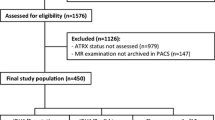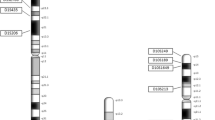Abstract
Lower grade gliomas are both treated and diagnosed via surgical resection. Maximum tumor resection is currently the standard of care; however, this risks the loss of brain function. Glioma can be genetically subdivided into three different types, based on isocitrate dehydrogenase (IDH) mutation status and the presence of 1p/19q codeletion, which have radically different prognoses and responses to adjuvant therapies. Therefore, the means to identify the subtype and evaluate the surrounding tissues during surgery would be advantageous. In this study, we have developed a new surgical strategy for lower grade glioma based on the fourth edition of the World Health Organization Brain Tumor Classification, involving intraoperative molecular diagnosis. High-resolution melting analysis was used to evaluate IDH mutational status, while rapid immunohistochemistry of p53 and alpha-thalassemia/mental retardation syndrome X-linked (ATRX) was used to evaluate the 1p/19q codeletion status, allowing genetic classification during surgery. In addition, intraoperative flow cytometry was used to evaluate the surgical cavity for additional tumor lesions, allowing maximal resection while mitigating the risk of functional losses. This strategy allows the rapid intraoperative diagnosis and mapping of lower grade gliomas, and its clinical use could dramatically improve its prognosis.




Similar content being viewed by others
References
Sanai N, Berger MS (2008) Glioma extent of resection and its impact on patient outcome. Neurosurgery 62(4):753–764 (discussion 264–266)
Lin Y, Smith ZA, Wong AP et al (2015) Predictors of survival in patients with spinal ependymoma. Neurol Res 37(7):650–655
Hardesty DA, Sanai N (2012) The value of glioma extent of resection in the modern neurosurgical era. Front Neurol 3:140
Duffau H (2013) A new philosophy in surgery for diffuse low-grade glioma (DLGG): oncological and functional outcomes. Neurochirurgie 59(1):2–8
Nitta M, Muragaki Y, Maruyama T et al (2013) Updated therapeutic strategy for adult low-grade glioma stratified by resection and tumor subtype. Neurol Med Chir (Tokyo) 53(7):447–454
Nitta M, Muragaki Y, Maruyama T et al (2015) Proposed therapeutic strategy for adult low-grade glioma based on aggressive tumor resection. Neurosurg Focus 38(1):E7
Fujii Y, Muragaki Y, Maruyama T et al (2017) Threshold of the extent of resection for WHO Grade III gliomas: retrospective volumetric analysis of 122 cases using intraoperative MRI. J Neurosurg 129(1):1–9
Gorlia T, Delattre JY, Brandes AA et al (2013) New clinical, pathological and molecular prognostic models and calculators in patients with locally diagnosed anaplastic oligodendroglioma or oligoastrocytoma. A prognostic factor analysis of European Organisation for Research and Treatment of Cancer Brain Tumour Group Study 26951. Eur J Cancer 49(16):3477–3485
Cairncross G, Wang M, Shaw E et al (2013) Phase III trial of chemoradiotherapy for anaplastic oligodendroglioma: long-term results of RTOG 9402. J Clin Oncol 31(3):337–343
van den Bent MJ, Brandes AA, Taphoorn MJ et al (2013) Adjuvant procarbazine, lomustine, and vincristine chemotherapy in newly diagnosed anaplastic oligodendroglioma: long-term follow-up of EORTC brain tumor group study 26951. J Clin Oncol 31(3):344–350
Cancer Genome Atlas Research, N, Brat DJ, Verhaak RG et al (2015) Comprehensive, integrative genomic analysis of diffuse lower-grade gliomas. N Engl J Med 372(26):2481–2498
Suzuki H, Aoki K, Chiba K et al (2015) Mutational landscape and clonal architecture in grade II and III gliomas. Nat Genet 47(5):458–468
Louis DN, Perry A, Reifenberger G et al (2016) The 2016 World Health Organization Classification of Tumors of the Central Nervous System: a summary. Acta Neuropathol 131(6):803–820
Shioyama T, Muragaki Y, Maruyama T et al (2013) Intraoperative flow cytometry analysis of glioma tissue for rapid determination of tumor presence and its histopathological grade: clinical article. J Neurosurg 118(6):1232–1238
Liu XY, Gerges N, Korshunov A et al (2012) Frequent ATRX mutations and loss of expression in adult diffuse astrocytic tumors carrying IDH1/IDH2 and TP53 mutations. Acta Neuropathol 124(5):615–625
Wiestler B, Capper D, Holland-Letz T et al (2013) ATRX loss refines the classification of anaplastic gliomas and identifies a subgroup of IDH mutant astrocytic tumors with better prognosis. Acta Neuropathol 126(3):443–451
Takami H, Yoshida A, Fukushima S et al (2015) Revisiting TP53 mutations and immunohistochemistry—a comparative study in 157 diffuse gliomas. Brain Pathol 25(3):256–265
Yordanova YN, Moritz-Gasser S, Duffau H (2011) Awake surgery for WHO Grade II gliomas within “noneloquent” areas in the left dominant hemisphere: toward a “supratotal” resection. Clinical article. J Neurosurg 115(2):232–239
Koriyama S, Nitta M, Shioyama T et al (2018) Intraoperative flow cytometry enables the differentiation of primary central nervous system lymphoma from glioblastoma. World Neurosurg 112:e261–e268
Kim SS, McCutcheon IE, Suki D et al (2009) Awake craniotomy for brain tumors near eloquent cortex: correlation of intraoperative cortical mapping with neurological outcomes in 309 consecutive patients. Neurosurgery 64(5):836–845 (discussion 345–346)
Beiko J, Suki D, Hess KR et al (2014) IDH1 mutant malignant astrocytomas are more amenable to surgical resection and have a survival benefit associated with maximal surgical resection. Neuro Oncol 16(1):81–91
Choi C, Raisanen JM, Ganji SK et al (2016) Prospective longitudinal analysis of 2-hydroxyglutarate magnetic resonance spectroscopy identifies broad clinical utility for the management of patients with IDH-mutant glioma. J Clin Oncol 34(33):4030–4039
Nagashima H, Tanaka K, Sasayama T et al (2016) Diagnostic value of glutamate with 2-hydroxyglutarate in magnetic resonance spectroscopy for IDH1 mutant glioma. Neuro Oncol 18(11):1559–1568
Saito T, Muragaki Y, Maruyama T et al (2016) Calcification on CT is a simple and valuable preoperative indicator of 1p/19q loss of heterozygosity in supratentorial brain tumors that are suspected grade II and III gliomas. Brain Tumor Pathol 33(3):175–182
Kanamori M, Kikuchi A, Watanabe M et al (2014) Rapid and sensitive intraoperative detection of mutations in the isocitrate dehydrogenase 1 and 2 genes during surgery for glioma. J Neurosurg 120(6):1288–1297
Ohka F, Yamamichi A, Kurimoto M et al (2017) A novel all-in-one intraoperative genotyping system for IDH1-mutant glioma. Brain Tumor Pathol 34(2):91–97
Kurimoto M, Suzuki H, Aoki K et al (2016) Rapid sensitive analysis of IDH1 mutation in lower-grade gliomas by automated genetic typing involving a quenching probe. Cancer Invest 34(1):12–15
Hatae R, Hata N, Yoshimoto K et al (2016) Precise detection of IDH1/2 and BRAF hotspot mutations in clinical glioma tissues by a differential calculus analysis of high-resolution melting data. PLoS One 11(8):e0160489
Pirro V, Alfaro CM, Jarmusch AK et al (2017) Intraoperative assessment of tumor margins during glioma resection by desorption electrospray ionization-mass spectrometry. Proc Natl Acad Sci USA 114(26):6700–6705
Acknowledgements
The authors are grateful to Mr. Takashi Sakayori and Ms. Asuka Komori (Department of Neurosurgery and Faculty of Advanced Techno-Surgery, Tokyo Women’s Medical University, Tokyo, Japan) for intensive laboratory work.
Author information
Authors and Affiliations
Corresponding author
Ethics declarations
Conflict of interest
The authors have no conflicts of interest to declare concerning the materials or methods in this study or the findings specified in this paper.
Ethical standards
The ethics committee of Tokyo Women’s Medical University (Tokyo, Japan) approved the research protocol, which was, therefore, performed in accordance with the ethical standards laid down in the 1964 Declaration of Helsinki and its later amendments. Each patient agreed to participate in the study and provided written informed consent.
Rights and permissions
About this article
Cite this article
Koriyama, S., Nitta, M., Kobayashi, T. et al. A surgical strategy for lower grade gliomas using intraoperative molecular diagnosis. Brain Tumor Pathol 35, 159–167 (2018). https://doi.org/10.1007/s10014-018-0324-1
Received:
Accepted:
Published:
Issue Date:
DOI: https://doi.org/10.1007/s10014-018-0324-1




